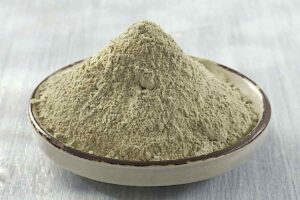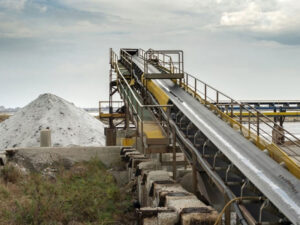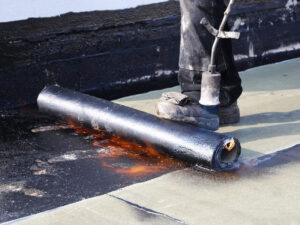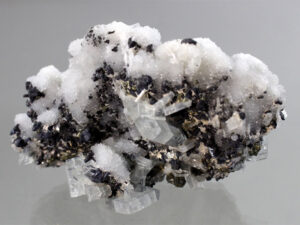Bentonite is an absorbent swelling clay consisting mostly of montmorillonite (a type of smectite) which can either be Na-montmorillonite or Ca-montmorillonite. Na-montmorillonite has a considerably greater swelling capacity than Ca-montmorillonite.
Bentonite usually forms from the weathering of volcanic ash in seawater, or by hydrothermal circulation through the porosity of volcanic ash beds, which converts (devitrification) the volcanic glass (obsidian, rhyolite, dacite) present in the ash into clay minerals. In the mineral alteration process, a large fraction (up to 40-50 wt. %) of amorphous silica is dissolved and leached away, leaving the bentonite deposit in place. Bentonite beds are white or pale blue or green (traces of reduced Fe2+
) in fresh exposures, turning to a cream color and then yellow, red, or brown (traces of oxidized Fe3+
) as the exposure is weathered further.
As a swelling clay, bentonite has the ability to absorb large quantities of water, which increases its volume by up to a factor of eight. This makes bentonite beds unsuitable for building and road construction. However, the swelling property is used to advantage in drilling mud and groundwater sealants. The montmorillonite / smectite making up bentonite is an aluminium phyllosilicate mineral, which takes the form of microscopic platy grains. These give the clay a very large total surface area, making bentonite a valuable adsorbent. The plates also adhere to each other when wet. This gives the clay a cohesiveness that makes it useful as a binder and as an additive to improve the plasticity of kaolinite clay used for pottery.
One of the first findings of bentonite was in the Cretaceous Benton Shale near Rock River, Wyoming. The Fort Benton Group, along with others in stratigraphic succession, was named after Fort Benton, Montana, in the mid-19th century by Fielding Bradford Meek and F. V. Hayden of the U.S. Geological Survey.Bentonite has since been found in many other locations, including China and Greece (bentonite deposit of the Milos volcanic island in the Aegean Sea). The total worldwide production of bentonite in 2018 was 20,400,000 metric tons.
Sodium bentonite
Sodium bentonite expands when wet, absorbing as much as several times its dry mass in water. Because of its excellent colloidal properties, it is often used in drilling mud for oil and gas wells and boreholes for geotechnical and environmental investigations. The property of swelling also makes sodium bentonite useful as a sealant, since it provides a self-sealing, low permeability barrier. It is used to line the base of landfills, for example. Bentonite is also part of the backfill material used at the Waste Isolation Pilot Project. Various surface modifications to sodium bentonite improve some rheological or sealing performance in geoenvironmental applications, for example, the addition of polymers.
Sodium bentonite can be combined with elemental sulfur as fertilizer prills. These permit slow oxidation of the sulfur to sulfate, a plant nutrient needed for some crops like onions or garlic synthesizing a lot of organo-sulfur compounds, and maintain sulfate levels in rainfall-leached soil longer than either pure powdered sulfur or gypsum. Sulfur/bentonite pads with added organic fertilizers have been used for organic farming.
Calcium bentonite
Calcium bentonite is a useful adsorbent of ions in solution, as well as fats and oils. It is the main active ingredient of fuller’s earth, probably one of the earliest industrial cleaning agents. It has significantly less swelling capacity than sodium bentonite.
Calcium bentonite may be converted to sodium bentonite (termed sodium beneficiation or sodium activation) to exhibit many of sodium bentonite’s properties by an ion exchange process. As commonly practiced, this means adding 5–10% of a soluble sodium salt such as sodium carbonate to wet bentonite, mixing well, and allowing time for the ion exchange to take place and water to remove the exchanged calcium. Some properties, such as viscosity and fluid loss of suspensions, of sodium-beneficiated calcium bentonite (or sodium-activated bentonite) may not be fully equivalent to those of natural sodium bentonite. For example, residual calcium carbonates (formed if exchanged cations are insufficiently removed) may result in inferior performance of the bentonite in geosynthetic liners.
Illitisation of smectite clays by potassium ions and K-bentonite rock
Illite is the main clay constituent of potash bentonite (a rock type also known as K-bentonite or potassium bentonite). K-bentonite is a term reserved to volcanic stratigraphy and tephrochronology and is related to the weathered clay rock type only. Illite, the clay mineral, is a potassium-rich phyllosilicate formed from the alteration of sematic clay in contact with groundwater rich in K+
ions.Illite is a high-charge TOT clay mineral, in which sheets are bound relatively strongly by more numerous potassium ions, and so it is no longer a swelling clay and has few industrial uses. In contrast to the highly hydrated Na+
ions which act as “swellers” or “expanders” ions, poorly hydrated K+
ions behave as “collapsers” when exchanging with Na+
ions accessible in the interlayers space present between two TOT layers. Dehydrated K+
ions are preferentially located in between two face-to-face hexagonal cavities formed by six joined silica tetrahedral present at the surface of the basal plane of a TOT layer (see the corresponding figure showing an elementary TOT layer). Because dehydrated, these K+
ions are sometimes said to form inner-sphere bonds with the surrounding oxygen atoms present in the hexagonal cavity hosting them. It means there is no water molecule in between the K+
ion and the oxygen atoms attached to the silica tetrahedral (T).
Uses
Creating a bentonite slurry for fining after wine pressing
Bentonite main uses are in drilling mud and as a binder, purifier, absorbent, and carrier for fertilizers or pesticides. As of around 1990, almost half of the US production of bentonite was used as drilling mud. Minor uses include filler, sealant, and catalyst in petroleum refining. Calcium bentonite is sometimes marketed as fuller’s earth, whose uses overlap with those of other forms of bentonite.
Drilling mud
Bentonite is used in drilling mud to lubricate and cool the cutting tools (drill bit), to remove cuttings, to stabilize the borehole walls, and to help prevent blowouts (by maintaining a sufficient hydraulic pressure in the well). Bentonite also curtails drilling fluid invasion by its propensity for aiding in the formation of mud cake. Much of bentonite’s usefulness in the drilling and geotechnical engineering industry comes from its unique rheological properties. Relatively small quantities of bentonite suspended in water form a viscous, shear-thinning material. Most often, bentonite suspensions are also thixotropic, although rare cases of rheopectic behavior have also been reported. At high enough concentrations (about 60 grams of bentonite per liter of suspension, ~6wt. %), bentonite suspensions begin to take on the characteristics of a gel (a fluid with a minimum yield strength required to make it move).
Binder
Bentonite has been widely used as a foundry-sand bond in iron and steel foundries. Sodium bentonite is most commonly used for large castings that use dry molds, while calcium bentonite is more commonly used for smaller castings that use “green” or wet molds. Bentonite is also used as a binding agent in the manufacture of iron ore (taconite) pellets as used in the steelmaking industry. Bentonite, in small percentages, is used as an ingredient in commercial and homemade clay bodies and ceramic glazes. It greatly increases the plasticity of clay bodies and decreases settling in glazes, making both easier to work with for most applications.
The ionic surface of bentonite has a useful property in making a sticky coating on sand grains. When a small proportion of finely ground bentonite clay is added to hard sand and wetted, the clay binds the sand particles into a moldable aggregate known as green sand used for making molds in sand casting. Some river deltas naturally deposit just such a blend of clay silt and sand, creating a natural source of excellent molding sand that was critical to ancient metalworking technology. Modern chemical processes to modify the ionic surface of bentonite greatly intensify this stickiness, resulting in remarkably dough-like yet strong casting sand mixes that stand up to molten metal temperatures.
The same effluvial deposition of bentonite clay onto beaches accounts for the variety of plasticity of sand from place to place for building sand castles. Beach sand consisting of only silica and shell grains does not mold well compared to grains coated with bentonite clay. This is why some beaches are much better for building sandcastles than others.
The self-stickiness of bentonite allows high-pressure ramming or pressing of the clay in molds to produce hard, refractory shapes, such as model rocket nozzles.









